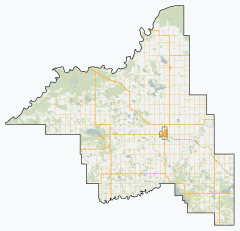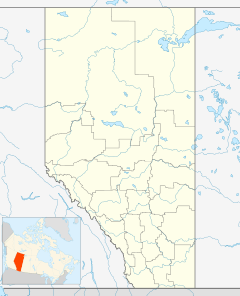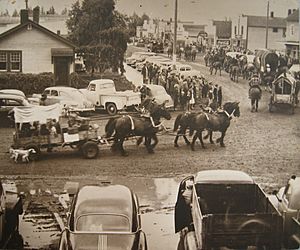Barrhead, Alberta facts for kids
Quick facts for kids
Barrhead
|
|||
|---|---|---|---|
|
Town
|
|||
| Town of Barrhead | |||
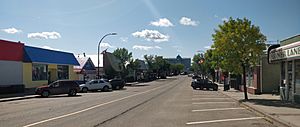
50th Street
|
|||
|
|||
| Motto(s):
"A quality community with a quality lifestyle"
|
|||
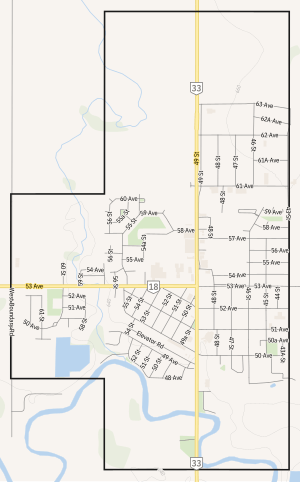
Town boundaries
|
|||
| Country | Canada | ||
| Province | Alberta | ||
| Planning region | Upper Athabasca | ||
| Municipal district | County of Barrhead No. 11 | ||
| Incorporated | |||
| • Village | November 14, 1927 | ||
| • Town | November 26, 1946 | ||
| Area
(2021)
|
|||
| • Land | 8.2 km2 (3.2 sq mi) | ||
| Elevation | 645 m (2,116 ft) | ||
| Population
(2021)
|
|||
| • Total | 4,320 | ||
| • Density | 527.1/km2 (1,365/sq mi) | ||
| Time zone | UTC−7 (MST) | ||
| • Summer (DST) | UTC−6 (MDT) | ||
| Forward sortation area |
T7N
|
||
| Area code(s) | 780 | ||
| Highways | Highway 18 Highway 33 |
||
| Waterway | Paddle River | ||
Barrhead is a town in central Alberta, Canada. It is surrounded by the County of Barrhead No. 11. The town sits along the Paddle River and at the crossing of Highway 33 (called the Grizzly Trail) and Highway 18. It is about 120 kilometers (75 miles) northwest of the city of Edmonton.
Barrhead is also on the path of the Express Trail. This trail was first used by First Nations people. Later, the North West Company used it for trade. The town was named after a town in Scotland. This was the birthplace of James McGuire, whose family were early settlers here. Barrhead's official bird is the great blue heron.
Contents
History of Barrhead
Early Settlement and the Klondike Trail
In the late 1800s and early 1900s, Barrhead was very important for settling northwest Alberta. Highway 33, known as the Grizzly Trail, follows the old Klondike Trail. This was the shortest way to the Yukon during the Gold Rush. This route helped people settle the Peace River region. The original Barrhead town site was a common stop for gold seekers. It was about 3 kilometers (1.9 miles) north of where the town is today. People stopped there to get supplies for their tough journey north.
Barrhead started in 1906. Its spot on the historic Klondike Trail made it a key trade center. It was a vital link for trade from Fort Edmonton to the Yukon. James McGuire, a child of early settlers, named Barrhead after his Scottish hometown.
Local Lore and Museum
Today, you can learn about the town's history at the Barrhead and District Museum. It has many old items. The museum also has a large display of African taxidermy. It is also the Barrhead Visitor Information Centre from May to September. The great blue heron is a local symbol. You can often see these birds along the Paddle River and local lakes. A statue of the bird is in the town center. Small statues of the bird are on street posts.
Land and Early Trails
The area used to have rolling hills with many trees. There were poplar, birch, pine, and spruce trees on higher ground. Lower areas had willow and tamarack trees. Not many people lived here for a long time. Cree natives passed through for 5000 years. They mainly settled around lakes like Shoal Lake.
In 1810, David Thompson explored a First Nations trail. This trail connected the North Saskatchewan River with Athabasca Pass. This created the first Canadian path across the country. In 1811, the first letter from British Columbia to Montreal came through this trail. Its importance for communication and trade grew. In 1824, Governor George Simpson asked for the trail to be widened. It went from Fort Assiniboine to Fort Edmonton. It passed about 1.6 kilometers (1 mile) east of the current town. This was to handle more traffic, sometimes 75 horses or more a day. Some large pack trains had over a hundred horses.
Changes to the Trail and New Settlements
Cree natives and trappers moved through the area. As they trapped more beavers, some dams broke. This flooded the Klondike Trail, and it was partly abandoned until 1898. During the gold rush, some gold seekers tried to use the trail. However, most preferred a drier route to Athabasca Landing. The trail was widened for horse teams and wagons. These wagons carried supplies for gold seekers going north. Homesteaders, or settlers who claimed land, soon followed.
Land surveys happened in 1906 and 1907. Pioneers applied for 160-acre (65-hectare) plots of land. Trading posts were busy on the Pembina and Athabasca rivers. A small store was open in the log home of Percy and Mary Johnstone. This was about 3.2 kilometers (2 miles) north and 1.6 kilometers (1 mile) east of town.
Growth of Services
A post office called Paddle River opened in 1907. It was on Ted Speck's farm, about 1.6 kilometers (1 mile) southeast of town. A store in Josh Cason's house opened in 1908. It was south and west of town. A small room there was used as a school. Hugh Critchlow had claimed land near the Klondike Trail in 1907. Soon, the Speck brothers built a bridge across the river. A sawmill started on the north side.
Cason and Critchlow built a store together at Critchlow's in 1910. The post office moved there. A hall was built nearby, where school was held from 1909 to 1911. A blacksmith shop and a swing were also there. Nearly a hundred people came to a picnic in 1909. In 1913, the Anglican Church was built. It was later moved to town in 1928 and then to Thunder Lake in 1967.
Barrhead Gets Its Name
The Paddle River Co-operative Society started in 1912. They opened a store in the old Johnstone building in 1913. They then built a new two-story building. The upstairs had room for community events. They needed a name for a new post office. The McGuire family suggested "Barrhead" after their hometown in Scotland. The Barrhead, Alberta, post office opened in the store on January 1, 1914.
The Finch family built a stopping house, which is still there. The North-West Mounted Police built a barracks. A blacksmith shop and a garage were built. A bus service to Edmonton started in 1926. The Toronto Dominion/TD Canada Trust bank opened in the stopping house. Children went to school at Glenreagh, about 3 kilometers (2 miles) west.
The Town Moves and Grows
In 1907, Albert Shelton and his family settled on the land where Barrhead's main street is now. They built a house and barn. The Sheltons moved in 1912. By 1927, the land was cheap. The Northern Alberta Railways agreed to bring a train line to this land. The people of Barrhead quickly moved their homes, the garage, and the store to this new spot. Four grain elevators were already being built there.
The streets and lots were carefully planned around the railway tracks. Buildings went up very fast. The way the lots were laid out is still used today. Soon, many businesses were open. There were grocery stores, hardware stores, a drug store, a restaurant, a hotel, and a real estate office. There was also a butcher shop, a livery barn, and the United Church. Ted Hooper supplied electric lights. Barrhead officially became a village in November 1927. A small hospital opened that fall. A new hospital was built in 1934.
The school opened in 1928. It was a two-room building. By 1929, another building was needed for the high school. Around this time, many people from Germany moved to the area. The town newspaper, the Barrhead News, started in 1927. It soon became the Barrhead Leader, which is the newspaper today. In 1936, a curling rink was built. In 1939, a movie theater opened. In 1946, the village got money to install water and sewer systems. On November 26 of that year, Barrhead became a town. Since then, the town has continued to grow and do well.
Geography of Barrhead
The Barrhead area has thick forests of spruce, birch, pine, and poplar trees. It also has some of the best farmland in Alberta. The town is located between two big rivers, the Athabasca River and Pembina River. The Paddle River, which flows into the Pembina River, goes right through Barrhead.
South and east of town, there are flatlands and river areas. To the west, you'll find Thunder Lake Provincial Park. This park is about 16 kilometers (10 miles) west of Barrhead. Thunder Lake is popular for boating, fishing, and camping. Many people from other parts of Alberta visit in the summer. The northern parts of the Barrhead region have thick stands of spruce, pine, and tamarack trees. There are also many other lakes in the county for camping and fishing. There is even a local ski hill in the Athabasca River valley.
Wildlife in Barrhead
The wildlife in the Barrhead area includes deer, moose, coyote, black bear, grizzly bear, mountain lion, and wolves. The county's symbol is the great blue heron.
Climate of Barrhead
Barrhead has a climate with four clear seasons. Summers are pleasant, and winters are very cold. Temperatures can reach over 35°C (95°F) in June, July, and August. They can drop to as low as -50°C (-58°F) in winter. However, winter temperatures in Alberta can change a lot each year.
The area gets a moderate amount of rain, mostly in the summer. It is wetter here than in nearby regions, especially to the south and east. About a meter (3 feet) of snow falls in winter. During the summer, it stays light late into the night. In winter, it gets dark quickly. But the town often sees beautiful displays of the Aurora borealis, also known as the Northern Lights.
| Climate data for Barrhead | |||||||||||||
|---|---|---|---|---|---|---|---|---|---|---|---|---|---|
| Month | Jan | Feb | Mar | Apr | May | Jun | Jul | Aug | Sep | Oct | Nov | Dec | Year |
| Record high °C (°F) | 15 (59) |
25.5 (77.9) |
20.6 (69.1) |
29.4 (84.9) |
33.3 (91.9) |
37.8 (100.0) |
37.2 (99.0) |
35 (95) |
32 (90) |
30 (86) |
22.2 (72.0) |
16 (61) |
37.8 (100.0) |
| Mean daily maximum °C (°F) | −8.2 (17.2) |
−3.6 (25.5) |
2.4 (36.3) |
11 (52) |
17.6 (63.7) |
20.7 (69.3) |
22.6 (72.7) |
21.7 (71.1) |
16.4 (61.5) |
10.4 (50.7) |
−0.8 (30.6) |
−6.6 (20.1) |
8.6 (47.5) |
| Mean daily minimum °C (°F) | −20.6 (−5.1) |
−17.4 (0.7) |
−10.5 (13.1) |
−3.1 (26.4) |
2.4 (36.3) |
6.9 (44.4) |
9.1 (48.4) |
7.8 (46.0) |
2.6 (36.7) |
−2.7 (27.1) |
−11.4 (11.5) |
−18.3 (−0.9) |
−4.6 (23.7) |
| Record low °C (°F) | −51.7 (−61.1) |
−50.6 (−59.1) |
−43.9 (−47.0) |
−32.2 (−26.0) |
−12.2 (10.0) |
−7.8 (18.0) |
−2.8 (27.0) |
−5 (23) |
−17.2 (1.0) |
−28 (−18) |
−45.6 (−50.1) |
−51.7 (−61.1) |
−51.7 (−61.1) |
| Average precipitation mm (inches) | 18.6 (0.73) |
15.5 (0.61) |
16.1 (0.63) |
24 (0.9) |
48.9 (1.93) |
105.3 (4.15) |
118.7 (4.67) |
83.2 (3.28) |
44 (1.7) |
16.9 (0.67) |
18.6 (0.73) |
23.4 (0.92) |
533.1 (20.99) |
| Source: Environment Canada | |||||||||||||
Demographics of Barrhead
Demographics means information about a population. In the 2021 Census, Barrhead had a population of 4,320 people. These people lived in 1,833 homes. This was a small decrease from its 2016 population of 4,579. The town covers an area of 8.2 square kilometers (3.2 square miles). This means there were about 527 people per square kilometer in 2021.
Economy of Barrhead
The main industries that support Barrhead's economy are oil and gas, forestry (working with trees), and agriculture (farming). Farmers in the area raise dairy cows, sheep, and other livestock. They also grow wheat and fruit crops.
Barrhead is home to a factory for Pollard Banknote Ltd. This company makes scratch-off tickets, pull-tab tickets, and bingo supplies. The town also has a factory that builds modular homes. Barrhead has several large companies. These include two major John Deere tractor dealers and KNM Sales and Services. These businesses serve the entire Barrhead county. The town also has many churches and two web development companies (bizuns and Slomp Technologies).
Infrastructure in Barrhead
Barrhead is home to the province's correspondence school. In 1991, this school was renamed the Alberta Distance Learning Centre. This center helps students learn from a distance.
Education in Barrhead
The town is part of the Pembina Hills Public Schools Division. This division was formed in 1995. Barrhead Composite High School serves the community. Its team won the national championship for "Reach for the Top" (a quiz competition) in 1973.
Sports in Barrhead
Barrhead has a junior ice hockey team. This team is part of the Western States Hockey League. They started playing in the 2019–20 season.
Sister Cities of Barrhead
Barrhead has "sister cities." This means it has special friendly relationships with towns in other countries.
Notable People from Barrhead
- Doug Horner, a former Deputy Premier of Alberta.
- Leland Irving, an ice hockey player who played for the Jokerit team in Finland.
- Janis Irwin, a Canadian politician and MLA for Edmonton-Highlands-Norwood.
- Ken Kowalski, a former Speaker of the Alberta Legislative Assembly and MLA.
- Melissa Lotholz, an Olympic athlete on the Canadian Two-Woman Bobsled team. She competed in the 2018 Winter Olympics.
- Alan May, a former NHL player and current hockey analyst.
- Brian Storseth, a former Member of Parliament.
- Arnold Viersen, a Canadian politician and Conservative Member of Parliament.
- Charles Yuill, a former mayor of Barrhead and a Member of Parliament from 1953 to 1958.




